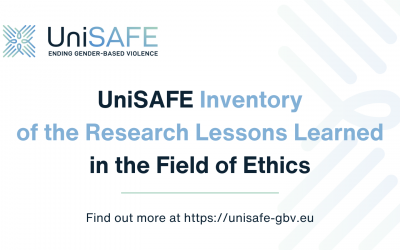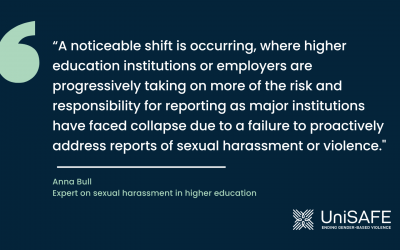To tackle gender-based violence, it is essential to first have an understanding of the scale of the problem. However, getting accurate estimates is far from a simple exercise. Dr Anne Laure Humbert, Professor of Gender and Diversity at Oxford Brookes University and UniSAFE partner, presents UniSAFE’s approach in measuring violence in research organisations and universities.
Gender-based violence from a wider perspective
Globally, about one in six women on average has experienced physical and/or sexual violence by an intimate partner in the past 12 months (United Nations Statistics Division). Survey data on the prevalence of violence in the EU estimated in 2012 that one in three women has experienced physical and/or sexual violence since the age of 15 (EU-wide survey on violence against women, European Union Agency for Fundamental Rights).
The EU-wide survey on violence against women is widely regarded as state of the art to measure the prevalence of violence against women in the EU, though it is not without its limitations (Walby, S. and Olive, P., 2014). Researchers have shown that the survey is very methodologically robust, and apt at measuring violence across women in a harmonised way across the EU (see for example for the case of intimate-partner violence Martín-Fernández, M., Gracia, E. and Lila, M., 2020). However, making comparison across Europe has highlighted what has then been termed the ‘Nordic Paradox’, that is the higher prevalence of violence against women in countries that are regarded as more gender equal such as Sweden or Denmark (Gracia, E. and Merlo, J., 2016).
While the reasons behind this paradox have yet to be fully elucidated, it has become clear that it points to the need to consider violence against women within a wider ecological framework that integrates individual-level factors with contextual ones at the level of society (Heise, L., 1998, Wemrell, M., Stjernlöf, S., Aenishänslin, J., Lila, M., Gracia, E. and Ivert, A.K., 2019, Humbert, A.L., Strid, S., Hearn, J. and Balkmar, D., 2021). The question of interest in any measurement of the prevalence of gender-based violence is therefore the extent to which the disclosure of experiences of violence corresponds to actual experiences – though it is clear that all measurement underestimates the true extent of the problem – and the factors that may be related to non-disclosure.
If data on violence against women is starting to emerge at EU and international level, however, little is known of the scale of the problem specifically within the context of research and/or higher education institutions such as universities. One of the aims of the UniSAFE project is therefore to provide an estimate of the prevalence of different forms of violence experienced by students and staff through a survey carried out in 47 institutions across 15 countries.
Giving a voice to all experiences of violence
The project relies on the definition of gender-based violence provided by the Istanbul Convention (Council of Europe Convention on preventing and combating violence against women and domestic violence): gender-based violence consists of acts “that result in, or are likely to result in, physical, sexual, psychological or economic harm or suffering to women” and that is “directed against a woman because she is a woman or that affects women disproportionately”.
The UniSAFE project survey measures incidents of violence related to these four different forms of gender-based violence, but also considers the problem of sexual harassment and online forms of violence as topics that are particularly relevant to the context of academic or research institutions (Cassidy, W., Faucher, C. and Jackson, M., 2017).
It also opts to measure gender-based violence beyond the experiences of women only. This recognises the role of gender in creating an asymmetry in experiences of violence, including the different forms they can take, their severity, frequency or consequences. It is grounded in an understanding that sees violence in itself as a regime of inequalities (Hearn, J., Strid, S., Humbert, A.L., Balkmar, D. and Delaunay, M., 2020). By extending measurement to all genders, including people that do not conform to the gender binary and stand between the two endpoints of the gender spectrum, it then becomes possible to understand how experiences of violence relate to inequalities, and the experiences of different groups.
The UniSAFE project is particularly interested in capturing not only the experiences of women as a whole, but also the effects of different (intersectional) factors such as sexual orientation, gender identity, ethnicity or international mobility, which may exacerbate exposure to the risk of violence.
Within the UniSAFE project, we strive to give a voice to all experiences of violence and understand the context in which they happen, to better understand how violence operates and its consequences, and with the aim in turn to inform the development of tools that can be used by academic and research institutions to eradicate violence within their midst.
Anne Laure Humbert
Professor of Gender and Diversity at Oxford Brookes University
UniSAFE partner



